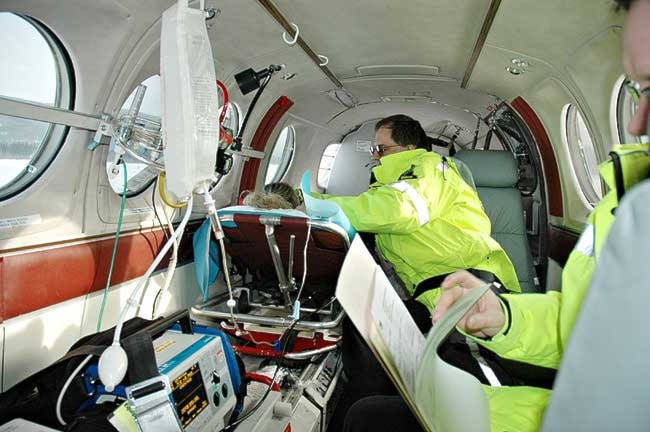The territory spends more than $10 million a year on medical travel.
And this worries Health Minister Glenn Hart.
So his department is paying Outside consultants more than $300,000 to review the numbers.
“We don’t anticipate any change to patient benefits, but we expect we may be able to realize savings in how we do our business,” said Hart in a news release issued Monday.
But patient benefits are already at risk, said Yukon flight nurse Steve Hahn.
When Hahn started working in the territory more than 13 years ago, the Yukon’s medevac program was one of the best in North America, he said.
But in the last few years, things have started to deteriorate.
Traditionally, every medevac had a dedicated flight nurse onboard, said Hahn.
Flight nurses have specialized training in advanced life support and can operate ventilators and dish out meds.
And that training is essential to ensure medevacs go smoothly, he said.
Imagine a patient who has severe pneumonia and is struggling to breath on the ground.
“Now, imagine taking them to altitude - throw in the cold air and the vibrations and they will start to decompensate,” he said.
But if a flight nurse is onboard to put the patient on a ventilator and medication they often arrive at the hospital “more stable than when they left the Yukon,” said Hahn.
However, flight nurses are being phased out, he said, blaming the cost and mismanagement.
Today, medevac flights often take off with just paramedics onboard.
“Primary care paramedics don’t have the scope of practice to offer appropriate care on medevacs,” he said.
“They can’t even give painkillers or cardiac drugs.”
And even advanced care paramedics are not trained at the critical care level, said Hahn.
Paramedics work “in the ditch,” he said.
And they are better than nurses at responding to emergencies in the field.
“We don’t have that experience,” he said.
That’s why, several years ago, Hahn lobbied the Department of Health to pair up flight nurses and advanced care paramedics on medevacs.
“I was excited to see advanced care paramedics come onboard and augment the program,” he said.
With one flight nurse and one advanced care paramedic on each flight, all bases were covered and Yukoners were getting optimal health care.
But about four years ago, the territory stopped hiring flight nurses, said Hahn.
“I was told we’re too hard to recruit and train,” he said.
“But they haven’t done the best job trying to recruit said nurses.
“The hospital understands how to recruit nurses, but not YTG.”
Hahn suspects it’s the advanced care paramedics lower salary that’s responsible for the nurse hiring freeze.
Flight nurses make about $2 more an hour, he said.
With that comes an ability to interpret blood chemistry, understand blood and gas values, and maintain advanced airway support.
Nurses can also work with doctors in the hospital, prior to a medevac, to make a detailed care plan for the patient, said Hahn.
“We don’t just treat one aspect during the stresses of flight,” he said.
Hahn was “excited to see advanced care paramedics come onboard and augment the program.
“But they were never meant to out-source or replace us as nurses,” he said.
In recent months, emergency medical services has been trying to trim its runaway budget.
For years, emergency services has blown its budget and overtime hours are largely to blame, said emergency services director Nicholas Tilgner in a previous interview with the News.
To cut overtime, Tilgner, who took the reigns in the fall, melded air and ground crews together.
Before, crews were effectively divided in two, with a ground crew, consisting of a minimum two ambulances ready to hit the streets and an air crew ready to staff the next medevac.
When someone on the ground crew called in sick, new paramedics were brought in on overtime pay to take the shift.
Now, if a ground crew calls in sick, the air crew will replace them in the ambulance.
And only if there is an air call will crews be backfilled.
The changes see Hahn and the other flight nurses doing time in the ambulance.
The new shifts caused some grumbling, but Hahn welcomes these changes.
He gets more “in the ditch” training and realizes the cost savings.
In fact, Hahn thinks the shifts should be overhauled again.
In his model, there would only be three teams. He’d cut out the swing shifts.
And medevacs would always be staffed by one advanced care paramedic and one flight nurse, who would also both work ground calls.
“This would potentially increase response times, involve less personnel and provide more capability,” he said.
“We do have the capability to run a fiscally responsible medevac team.”
Keeping a flight nurse on each medevac would save taxpayers money, he added.
Offering patients advanced life support during transport means less time in southern hospitals, said Hahn.
“But if we just focus on critical care, it results in poor patient outcomes and longer times in intensive care units, which costs the taxpayer.”
The $300,000 medical travel review is set to be completed by Winnipeg consultants Meyers, Norris, Penny LLP by March 2012.
Over the last two weeks several calls were made to Emergency Medical Services. No response came before press time.
Contact Genesee Keevil at
gkeevil@yukon-news.com
